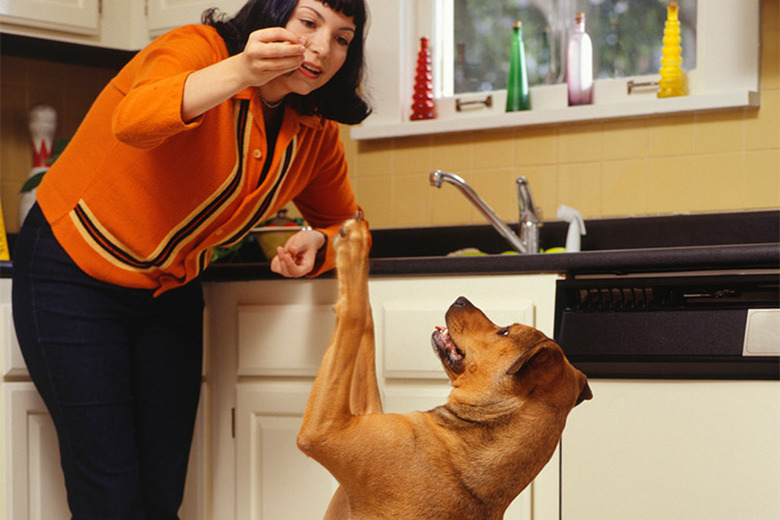Why Do Dogs Lift Their Paws To Beg?
Among the many things dogs do, putting the paws up to make a request remains one of the most funny and adorable behaviors. Whether Scruffy paws to beg for a piece of juicy steak or to request more petting from a guest, it's sure to bring attention and even some laughs. If you ever wondered why your dog engages in this behavior, a closer look into doggie psychology reveals that dogs tend to repeat behaviors that they are either taught (or have naturally stumbled upon) and are then reinforced.
History of "Giving Paw"
For a good reason, some trainers aren't too keen on teaching a dog to give a paw. As much as the trick looks quite cute, it can get easily out of "hand" if the dog owners are not too careful. While it's true many dogs learn to give paw when asked to, some dogs learn to give paw in many other circumstances even when not asked. This translates into dogs pawing to demand play, pawing for attention or pawing to just remark: "Hey, it's dinner time, now get up and make it happen."
Natural Pawsibilities
You know you own a "natural" when Scruffy starts opening your cabinets and doors and handles toys and other objects with his paws. Many "pawsy" dogs didn't have to learn to use their paws to get what they want; rather, the behavior came to them quite naturally on their own initiative. Of course, Scruffy wouldn't put his paw up if this action wouldn't result in some type of desired consequence. Would you keep raising your hand if your teacher always ignored it? Most likely you would stop raising your hand since it didn't work and would try something different.
History of Reinforcement
A good explanation for your dog's persistent pawing behavior comes from American psychologist Edward Thorndike. His law of effect claims that responses known for producing a satisfying effect in a specific situation become more likely to reoccur in that situation, and responses known for producing a discomforting effect become less likely to reoccur in that situation. If every time your dog paws he gets attention, a piece of steak or gets to play his favorite game, you can bet he'll be pawing more and more.
Reducing the Behavior
While a pawing dog may look cute, the trick may become old when your dog is constantly pawing. If you want to reduce the behavior, you may find American psychologist's B. F Skinner's twist on the law of effect helpful. He claimed that reinforced behaviors tend to be repeated, whereas non-reinforced behaviors tend to die out or extinguish. This means that if you totally ignore the pawing behavior and no longer fuel it with any type of attention, your dog will paw less and may eventually stop.
Don't Give a Paw About it
As you start ignoring the pawing behavior, be prepared to see a strong increase in the pawing behavior. This is known as an extinction burst and is a sign that ignoring the behavior is actually working. If Scruffy could talk, he might say: "Don't you see my paw? I'll paw more in case you didn't notice it." If you further ignore this behavior, your dog will eventually give up trying and you'll see a reduction in the pawing behavior. If you reward it though, you'll be stuck and the pawing behavior will soon be back, stronger than ever.
Putting Paws to Good Use
While ignoring the inappropriate, pushy pawing behavior will cause it to extinguish, you can put the pawing behavior to good use. If your dog is predisposed to pawing, you can train him to shake, wave, high five and salute. If your dog is talented, you can even train him to turn on appliances, push a ball and even play the piano. When you give your dog the command, give attention and praise him lavishly, and when you notice persistent, annoying pawing behavior, ignore it. Your dog will learn that pawing is on your terms and he should paw only when you ask for it.
By Adrienne Farricelli
References
Simply Psychology: Edward Thorndike
Simply Psychology: Skinner – Operant Conditioning
Dog Science: Extinction Burst
Whole Dog Journal: Understanding How Dogs Communicate With Each Other
Dog Obedience Training: Shake-a-Paw Dog Trick
About the Author
Adrienne Farricelli has been writing for magazines, books and online publications since 2005. She specializes in canine topics, previously working for the American Animal Hospital Association and receiving certification from the Certification Council for Professional Dog Trainers. Her articles have appeared in "USA Today," "The APDT Chronicle of the Dog" and "Every Dog Magazine." She also contributed a chapter in the book " Puppy Socialization – An Insider's Guide to Dog Behavioral Fitness" by Caryl Wolff.
